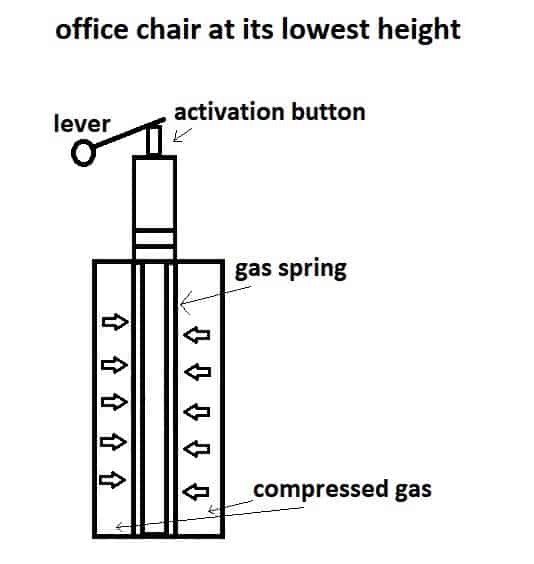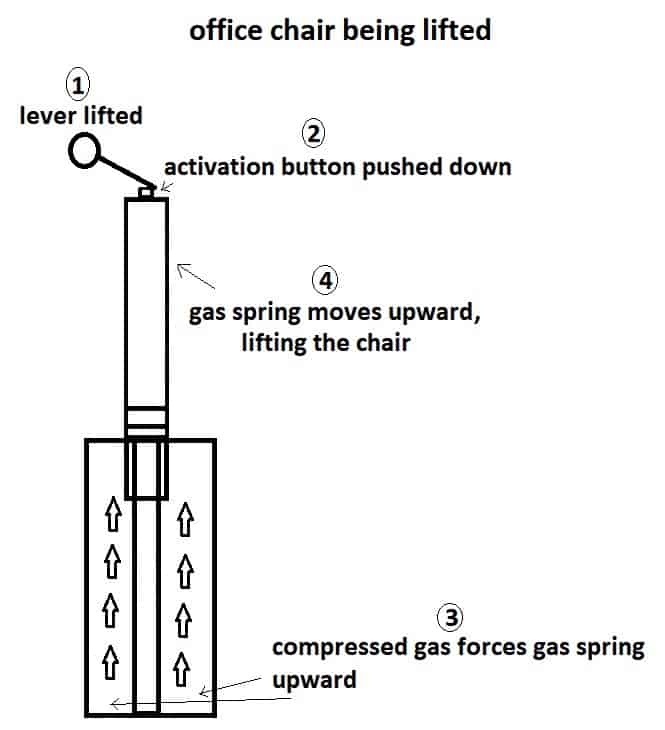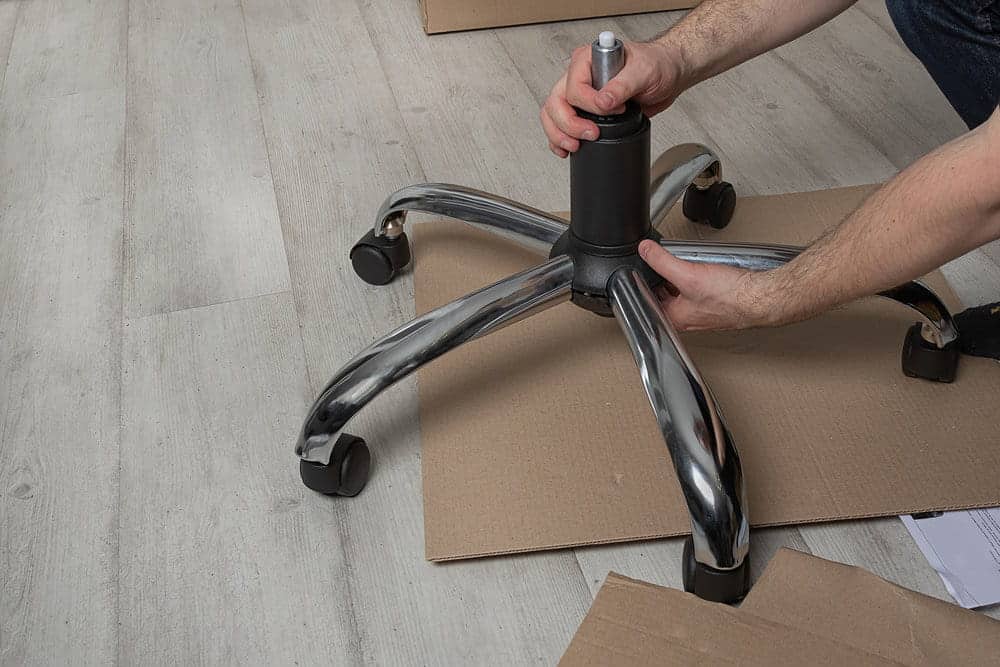Office chair cylinders
It’s the heart of every office chair.
It helps give the chair its structure…
And, more importantly, it allows you to adjust the height of your chair for better ergonomics.
But have you ever wondered how these cylinders work?
Why does your chair lift when you pull the lever?
Or why these cylinders stop working after a while?
Today, we’re going to answer all these questions for you.
We’ll look at:
- The two types of office chair cylinders
- Exactly how pneumatic cylinders work
- Exactly how hydraulic cylinders work
Plus, we’ll answer the most frequently asked questions about office chair cylinders.
Are you ready? Let’s get to it!
Table of Contents
The 2 Types of Office Chair Cylinders
There are two types of office chair cylinders: Pneumatic and Hydraulic.
Most office chairs use pneumatic cylinders. Some people even call all height-adjustable chairs “pneumatic” chairs.
Both of these cylinders might work the same way, but they have some KEY differences.
Let’s take a closer look at each one.
How the Pneumatic Cylinder Works
Have you ever used a bicycle pump before?
As you push down on your pump, this compresses the air inside the tube. The compressed air is forced out through the nozzle of your pump and into your bicycle’s tire.
Pneumatic cylinders work in a similar way.
The difference is, there are high levels of pressure inside the pneumatic cylinder.
Instead of a simple air chamber, pneumatic cylinder chambers are filled with pressurized nitrogen.
To make things worse (or should we say, better) these chambers are completely sealed. The high pressure of these cylinders is stuck in there.
There is a way to release some of this pressure, though.
This is through the gas spring – a moving part of the cylinder that’s locked in place.
When unlocked (which you can do by pulling your chair’s lever), the high pressure will push the gas spring upwards. This raises the chair.


This is what goes on behind-the-scenes whenever you raise your office chair.
So then how does your office chair sink?
Well, if you unlock the spring and sit on the chair, it’ll be pushed back down.
The nitrogen gas is no match against your weight. It’ll have to accept the spring back into the chamber, lowering the chair’s seat.
You might be wondering, “but how can an office chair lock its height midway?”
Simple.
Whenever the activation button isn’t pressed down, the spring locks in place. No amount of pressure or weight can budge it.
That’s how a pneumatic cylinder works.
Smart, right?
How the Hydraulic Cylinder Works
Hydraulic cylinders work the same way.
However, these have two chambers instead of one. And they’re full of fluids instead of nitrogen.
One chamber is full of high-pressure incompressible oil. While the other has an expandable piston.
Both chambers are connected at the bottom. But there’s a valve that blocks the high-pressure oil from forcing its way into the piston chamber.
If you lift the adjustment lever, the valve opens, allowing the fluid to enter the piston chamber.
The pressure of the entering fluid forces the piston upward.
Since it’s incompressible oil, it’s strong enough to lift the weight of the piston. And that lifts the chair seat as well.
Like pneumatic cylinders, hydraulic chairs don’t go down automatically when you pull the lever. You need to add weight.
This is because these are single-acting cylinders.
To make them sink, you’ll need to pull the lever AND sit on your chair.
When you do this, you’ll force the piston downwards. This also forces the oil back across the valve and into its chamber (again, the oil is no match for your weight.)
Check out this video to get an idea of how it works:
Related post: Can Office Chairs Explode?
Frequently Asked Questions About Office Chair Cylinders

You might still have a few questions in your mind. Perhaps it’s one of these three frequently asked questions.
1. Can Office Chair Cylinders Explode?
You might be thinking, “since these cylinders work with intense pressure, what will happen if there’s a leak? Will the cylinder explode?”
No.
Or at least you never have to worry about it.
It can explode. But these are one in a million types of cases.
And, they never happen in the office either. The only time cylinders explode is during factory testing.
When you get an office chair, you can rest assured it’s been tested already.
So there’s absolutely no need to worry about explosions.
2. Why Do Office Chair Cylinders Become Faulty?
One of the most common office chair problems is that the cylinder can no longer hold your weight.
Whenever you sit in your office chair, it sinks.
Frustrating!
“Why does this happen?”
First, it could be because of a leak.
When there’s a hole in the cylinder, all pressure – whether it’s from nitrogen or oil – will escape.
The more likely reason, though, is that the mechanics of the cylinder are worn out.
When this happens, your cylinder becomes too weak to hold the gas spring (or piston) in place. This is why whenever you add weight, your chair will sink.
If you’re experiencing this problem, click here to learn how to fix it yourself.
3. Can I Replace a Pneumatic Cylinder With a Hydraulic Cylinder?

If your cylinder is faulty, you’ll need to replace it.
Now, you might be wondering, “Is it possible to use a hydraulic cylinder in place of a pneumatic cylinder (and vice versa)?”
No, it isn’t.
Office chairs are built for only one cylinder type.
Sure, you can replace your cylinder. But you’ll need the exact same specs right down to the length of the spring or piston.
If it isn’t a pinpoint match, the cylinder won’t work or even fit.
Don’t be tempted. Pneumatic replacements are easier to find, and hydraulics are longer lasting.
But remember, you’re better off sticking to what your chair was using originally.
Conclusion
And that’s how office chair cylinders work.
Now you know the complex inner-workings of your chair.
So next time you adjust your chair’s height, picture what’s going on.
If you’re interested to know how other office chair parts work, click here.

My name is Vance, and I am the owner of To Ergonomics. Our mission is to improve your workflow by helping you create a supportive and welcoming environment. We hope that you’ll find what you’re looking for while you’re here.


Patty Mackey
Tuesday 12th of January 2021
During assembly; the gas lift cap had not been removed before inserting it into the chair base tubular column; consequently; the cap is now stuck tightly within the tubular column and we can’t seem to get it out; and can not access the gas lift mechanism with the cap in the way